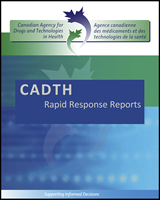Severe asthma is a chronic condition in which patients experience airway inflammation and airway muscle contraction leading to symptoms of breathlessness, wheezing, coughing, and chest tightness. It is one of the most common chronic conditions with an estimated 235 million people affected worldwide, an increasing global prevalence, and a lifetime of impacts on healthcare systems. Exacerbations of this condition can be serious, negatively impact patient quality of life, require hospitalization and emergency department (ED) services. The standard approach to care employs regular maintenance medications, usually inhaled corticosteroids (ICS) and a long-acting β2-agonist (LABA), while other medications may also be used including omalizumab and oral corticosteroids. Bronchial thermoplasty (BT) is an endoscopic therapy, the first nonpharmacologic intervention approved by Health Canada for the treatment of severe asthma. BT employs radiofrequency energy pulses to selectively reduce the thicker airway smooth muscle found in asthmatic patients. This selective ablation is thought to reduce airway hyper-responsiveness, airway obstruction, and asthma symptoms. Further research is required to help more clearly determine the mechanisms of action of bronchial thermoplasty. Limitations of the technique include the inability to treat distal symptomatic airways due to their small diameter, and contraindications for patients with implanted medical devices.
This report is an update to a previous Canadian Agency for Drugs and Technologies in Health (CADTH) Rapid Response Report published in March 2014 that provided a summary of abstracts on bronchial thermoplasty. The purpose of this report is to retrieve and review the current evidence from full text articles of clinical efficacy, safety, and cost-effectiveness of BT. In addition this report aims to retrieve and review existing guidelines on the use of BT for the treatment of severe asthma.
Contents
- CONTEXT AND POLICY ISSUES
- RESEARCH QUESTIONS
- KEY FINDINGS
- METHODS
- SUMMARY OF EVIDENCE
- CONCLUSIONS AND IMPLICATIONS FOR DECISION OR POLICY MAKING
- REFERENCES
- APPENDIX 1 Selection of Included Studies
- APPENDIX 2 Summary of Study Characteristics
- APPENDIX 3 Summary of Critical Appraisal
- APPENDIX 4 Summary of Findings

